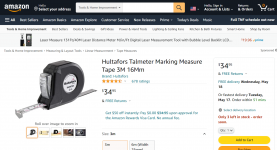bwehman
Member
- Joined
- Mar 21, 2016
- Messages
- 335
Been in the Festool eco system for several years but finally with the purchase of the parallel guides, of all things, decided to fully commit to metric. I know it shouldn't make a difference in theory, but for some reason I feel like metric necessitates more precision.
That being said, for lengths longer than 12" I've been using a FastCap metric tape measure with a flat tape. Thing is, the measurement can be millimeters off depending on how square the end of the tape measure is on the reference surface, and when I'm trying to nail the position of a domino, it matters.
What is everyone else using? I guess one option is an army of T-squares and rulers?
That being said, for lengths longer than 12" I've been using a FastCap metric tape measure with a flat tape. Thing is, the measurement can be millimeters off depending on how square the end of the tape measure is on the reference surface, and when I'm trying to nail the position of a domino, it matters.
What is everyone else using? I guess one option is an army of T-squares and rulers?


